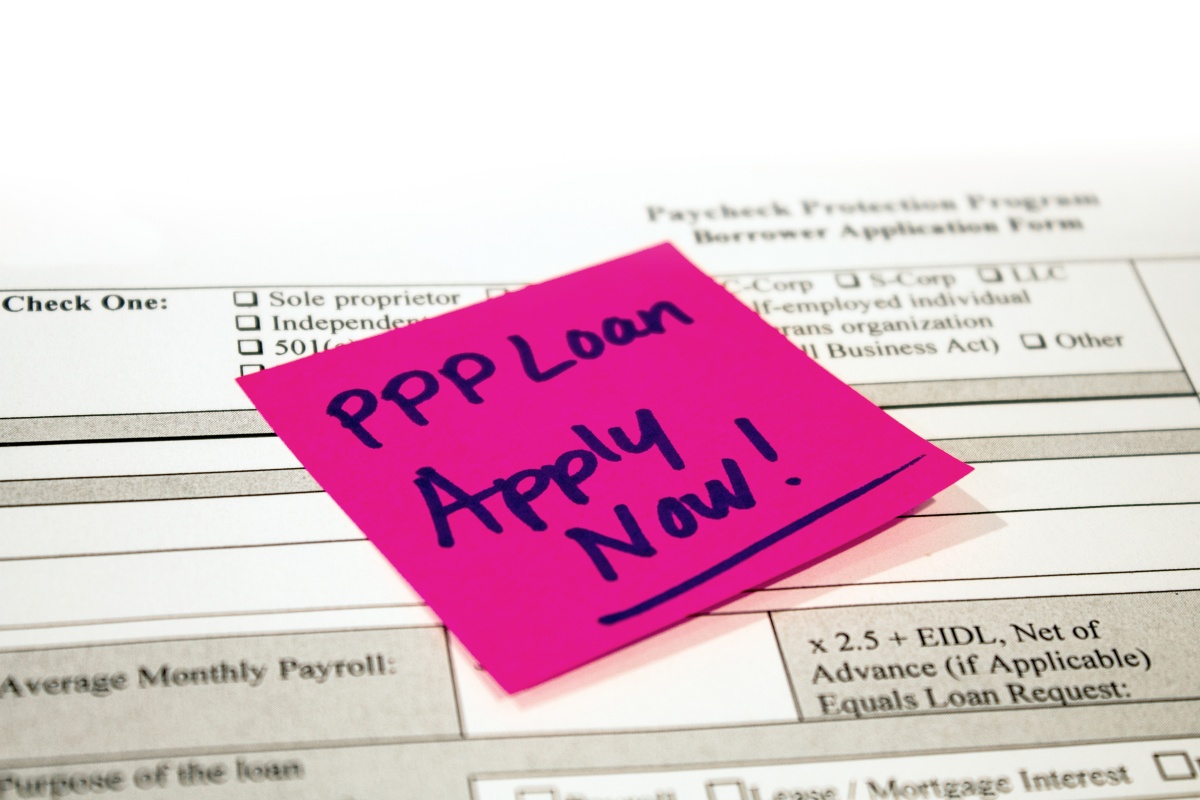What is the Paycheck Protection Program and how can your business get a loan?

In this article:
- Frequently asked questions about PPP loans
Due to the recent economic downturn caused by the COVID-19 pandemic, many business owners, sole proprietors, and independent contractors have been given the opportunity to apply for a loan through the Paycheck Protection Program (PPP). This program is made possible by the recent $2 trillion CARES Act. It is the hope of the federal government that these loans will help businesses carry on through the economic impacts of the virus and to keep their employees. With the help of the Small Business Association (SBA), businesses can apply for loans through the PPP.
Throughout this article, we’ll answer several common questions about the PPP loan and how your business can benefit from it.
Important note: The PPP has already run out of its first round of funding, so if you want to receive a loan you should put your application in as soon as possible. Check out this article to apply for your loan and find certified agents and eligible lenders.
Has all the PPP money been spent or allocated?
On April 16, 2020, the original amount of $350 billion dedicated to the Paycheck Protection Program had run out. However, it is estimated that only a few of those loans have been funded. Even with the money already allocated to other businesses, you should still apply for a loan if you haven’t already. It’s likely that the CARES act will receive another $250 billion later, if not more. Similarly, the EIDL grant is out of money, though hopefully, that program will also receive additional funding.
Our big takeaway is that if you are in need of funding to help keep your business afloat right now, get your PPP loan application in asap. There's no guarantee that you will get this loan, but the sooner you get your application in, the better chance you have.
The SBA is offering other emergency funding grants and loans at this time as well. For more information, visit SBA.gov.
How much does it cost to apply for a PPP loan?
Applying for a PPP loan through the SBA is free. Approved SBA lenders and loan agents are compensated by the SBA so you don’t need to worry about spending money to get help. If you are asked to pay for assistance with the application or any fees, you should find someone else to help you. Likewise, you don’t need any collateral for the loan and shouldn’t be asked to use any.
What is the interest rate for PPP loans?
The interest rate for a PPP loan is a fixed amount of 1.00%. The interest rate will not vary by the lender because it is sponsored by the federal government.
What are the terms of a PPP loan?
A PPP loan will be the same no matter where you go to apply. Every business has the same terms for their loans:
- Loans can be forgiven if they cover payroll costs, mortgage, rent, utilities, and employee compensation levels are maintained
- Payroll costs are capped at an annual $100,000 for each employee
- Payments are deferred for six months, though still generating interest
- Loan amounts can be the amount of two months of your average payroll costs from the last year, plus 25%
- The loan is due in two years (if it isn’t forgiven)
Who can apply for the SBA grant or PPP loans?
To apply for any Small Business Association grants or Paycheck Protection Program loans, your business must have less than 500 employees with principal residences in the United States, and you need to have been in operation since February 15, 2020.
Many other organizations like nonprofits, veteran organizations, tribal concerns, faith-based organizations, self-employed individuals, sole proprietors, and independent contractors are also eligible for loans.
Is my business still eligible for a loan if I have multiple locations?
If you meet all the other criteria even with multiple locations, you can still apply for a PPP loan. However, you may have to submit more than one application depending on how your tax IDs are set up. If you only have one tax ID for your locations, you’ll only need to submit the application once. If you have multiple IDs, you’ll need to submit an application for each of them.
How do I apply for a PPP loan if I am in a partnership?
If your business is a partnership, do not file separate loan applications as a self-employed individual. Instead, report the income of the general, active partners as payroll cost on the application and file on behalf of the partnership.
Can I get a PPP loan if I just started my business this year?
To qualify for the PPP loan, your business must have been operating at least since February 15, 2020. Since you won’t have an annual history of payroll costs to analyze for your average costs, you’ll have to calculate your loan based on your average total monthly payroll costs incurred from January 1 to February 29, 2020 and multiply it by 2.5.
Do I qualify for a PPP loan if I just started as an independent contractor or am self-employed?
For sole proprietors, independent contractors, and those who are self-employed, you will need to have provided the 2019 Form 1040 Schedule C with your PPP loan application and a 2019 IRS Form 1099-MISC detailing non-employee compensation. You will also need to provide records that prove you are self-employed and were in operation on or around February 15, 2020. Although February 15, 2020, is the cut-off date for most businesses applying for the PPP loans, self-employed individuals will need 2019 tax documents to be eligible for the loan due to the lack of verifiable documentation on expenses from February 15.
If I have more than 500 employees, can I still get a PPP loan?
Although it is a requirement for the PPP loan to have less than 500 employees, some businesses may still be eligible, depending on their industries.
Refer to section 3 of the Small Business Act, 15 U.S.C. 632. Your business might qualify for a loan if it meets the SBA employee-based or revenue-based size standard corresponding to its primary industry. Alternatively, a business may qualify as a small business concern if it met both requirements in the SBA’s “alternative size standard,” of March 27, 2020, which are: (1) maximum tangible net worth of the business is not more than $15 million, and (2) the average net income after federal income taxes of the business for the two full fiscal years before the date of the application was not more than $5.
If I have a seasonal business, can I still apply for a PPP loan?
Owners of seasonal businesses can apply for a PPP loan as long as they meet all the loan requirements. You will need to calculate the amount of the loan using the average payroll costs from February 2019 to June 2019 to determine how much you can apply for.
If I’ve laid off employees can I get a PPP loan? What if my business closed?
If your business closed between February 15, 2020, and April 26, 2020, you may still be eligible for a PPP loan. If you closed before that time, you do not qualify for the program. To qualify for a PPP loan, you’ll need to restore your business, employment levels, and salaries by June 30, 2020. If you want to qualify for loan forgiveness, you’ll want to complete this process quickly.
With the high demand of the PPP loans, it is not likely to last as long as June 30, so it is important to get your application and documentation submitted as soon as possible.
How much can I borrow for a PPP loan?
Small businesses can borrow 2.5 times their average monthly payroll costs, as long as that number does not exceed $10 million. Employee salaries over $100k are capped at that amount. To qualify for a PPP loan and forgiveness of the loan, you must be able to certify that you will be using 75% or more of your loan to maintain employees and their compensation levels.
How do I calculate the loan amount that I can apply for?
To calculate your average monthly payroll, you’ll need to provide payroll documentation. This information will help you determine how much you can borrow. Even if you haven’t paid anyone or yourself within the last couple of months, you’ll need to mark the payroll amount as something greater than zero, otherwise, you’ll need to reapply.
To calculate the correct number for a paycheck protection program loan, you’ll need to multiply your average monthly payroll by 2.5 and round to the nearest dollar. However, this is only if your business has not received loans or advances from the Economic Injury Disaster Loan program in 2020. If you have received funding in 2020, you’ll need to contact your loan provider for help determining the accurate number.
Who can act as an approved facilitator or agent for Small Business Association/Paycheck Protection Program loans?
A loan agent can be an attorney, accountant, consultant, or loan broker, as long as they are an authorized representative of your company. People who don’t want to work directly with their banks for submitting their applications can use a loan agent instead. This can help applications get submitted and processed quicker and easier than doing it on your own.
No fees should be paid by a business owner to submit a PPP or SBA loan. A business should only pay if one of their employees is filing the information on their behalf.
If my bank isn’t an approved SBA lender, where can I go for a PPP loan?
Most banks are a part of the SBA approved lender network, however, they may still choose not to accept applications for loans. You can go to another lender if this is the case for you, or if your bank is not a part of the SBA’s approved lender program.
You can use SBA.gov to find approved lenders near you. These lenders will typically be personal banks, credit unions, or private lenders.
What should I look for in an SBA/PPP loan agent or facilitator?
If you are looking for a third party to help you with your PPP loan or another SBA application, find an agent or agency that has the staff and time necessary to support your needs and answer your questions. You’ll also want to know if they charge for their services (they shouldn’t) and if their assistance is based on the guidelines of the U.S. Treasury.
How long does it take to receive SBA/PPP loans?
Once a loan has been submitted and approved, your business should receive its first payment within 10 days. Being thorough with your paperwork and application will help it go through the process faster. However, it is not clear how long the approval process will take. Since there are many businesses scrambling for these loans, delays are to be expected.


